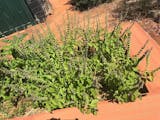The perennial dyer's chamomile is an undemanding wild scent and dye plant that was used in the Middle Ages to dye wool yellow. Beautiful bee pasture. The flowers give off a wonderful scent, typical of chamomile. Ideal for direct sowing or pre-cultivation, pot culture possible, sowing spring-summer, good for mixed culture, harvest the flowers.
Description
The dyer's chamomile is an old wild perennial scented and dyeing plant that was used in the Middle Ages to dye wool yellow and is native to parts of Europe and Asia. The robust and drought-tolerant plants are continuous bloomers, form a beautiful bee pasture with their countless golden yellow flowers and have no special soil requirements. The plants develop narrow, feathery leaves that are covered in gray, felty hairs on the underside. The flowers give off a wonderful scent that is typical of chamomile.
General information
Plant family: Asteraceae
Life cycle: Perennial
Days to harvest: 100 days
Plant height approx.: 80 cm
Root type: Deep and shallow rooter
Nutrient requirements: Low
Water requirements: Low
Winter hardiness: Up to -20°C
Location: Sunny
Soil: Permeable, sandy, stony, loamy, humus
pH value: 5.5 to 7
Sowing and planting information
Germination type: Light germinator
Sowing depth: 0 cm
Optimal germination temperature: 18-22 °C
Germination time: 5-14 days
Plant and row spacing: 30x50 cm
Germination ability of seeds: 3-4 years
Mixed culture
Optimal mixed culture: -
Unfavorable mixed culture: -
Sowing by climate zone
Subtropic climate (Mediterranean) (e. g. B. Portugal, Spain, Italy)
Direct sowing from February to May is recommended. The plants should ideally be planted in a sunny location.
Moderate climate (e. g. B. Germany, Switzerland, Poland)
Direct sowing from April to June is recommended. The plants should ideally be planted in a sunny location.
General recommendations
Direct sowing is recommended. After germination, thin out the plants to the specified plant spacing. Pre-cultivation is also advisable.
Dyer's chamomile ideally prefers a soil that is moderately nutrient-rich, dry to moist and permeable, containing sand, stones, clay and humus. It does not tolerate waterlogging.
Additional tips
It easily self-seeds and establishes itself in the garden without spreading too much. Soil that is too moist results in fewer flowers and promotes leaf growth. In order to quickly obtain a fine, crumbly and permeable soil with good nutrient and water storage capacity, it is recommended to add biochar and rock flour.
Type of propagation
Propagation occurs via seeds or root division.
Plant care
Cutting back to a height of 10cm in September will result in strong new growth in the same year. Fertilizing with plant manure in spring is recommended to encourage strong new growth.
Other names
Botanical names: Cota tinctoria, Anthemis tinctoria
English names: Dyer chamomile
German names: Färberkamille, Färber-Hundskamille
Portuguese names: Camomila de tintureiro
Spanish names: Manzanilla tintorera
French names: Camomille teinturière
Origin
Country: Portugal



![<tc>Dyer Chamomile [Cota tinctoria]</tc>](http://www.benjis.net/cdn/shop/files/Faerberkamille-Dyerchamomile-Camomiladetintureiro-Anthemistinctoria-www.benjis.net.jpg?v=1710279121&width=1445)










